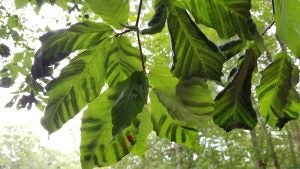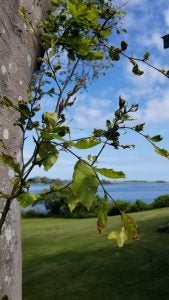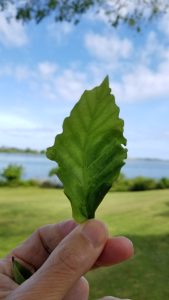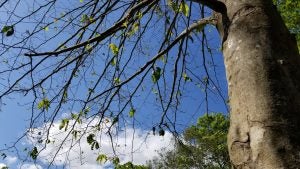Beech leaf disease in RI
We are seeing a new disease of beech trees throughout Rhode Island – beech leaf disease (BLD). It’s caused by a foliar nematode and can kill American and European beech trees. The disease was first seen in Ohio in 2012 and quickly spread east. It was found in RI in 2020 in Ashaway. In 2020 it appeared to be confined to a 5-mile diameter area in Ashaway. In 2021 it was found in many locations in Washington County, Newport County, and in some locations in Kent County. This year BLD symptoms are severe throughout Washington County and infected trees have been found in Providence County. I haven’t checked trees in Bristol County yet this year.
The only good thing about this disease is it’s easy to identify. The foliar nematode, Litylenchus crenatae, causes banding on American beech leaves which can best be seen by backlighting infected leaves against the sky. More advanced symptoms of the disease include deformed leaves that are leathery and crinkled. Symptoms on European beeches are less distinctive, but the banding is still visible. Infected European beech leaves tend to be torn and malformed.
American beech leaves with stripes/bands of beech leaf disease.
European copper beech with malformed leaves. Leaf banding may not be as visible.
BLD nematodes overwinter in leaf buds and leaves emerge in the spring showing symptoms. Leaves that get infected later in the season do not develop visible symptoms. Foliar nematodes need a film of water to move around on a leaf or to move to a new leaf. We don’t know how the nematodes are transmitted long distances. It may be birds or insects or some other vector.
Trees showing symptoms the first year still appear healthy. Within 2-4 years, an infected tree loses many leaves and the canopy is greatly reduced. In Ohio they see trees dying in 6-10 years.
Very thin canopy of BLD-infected American beech tree.
This is a new disease and we have more questions than answers. We don’t know where it came from originally and we don’t know how it spreads from one infected area to another. We also don’t know how to manage this disease. In Ohio researchers have some encouraging results treating trees with potassium phosphite products. Phosphites have been used succesfully against other plant diseases and tend to stimulate the plant’s natural defenses. Phosphite products have been used for many years against Phytophthora bleeding canker disease of beeches.
There are several Phosphite products including Agrifos and Prophyt. Researchers in Ohio have used Polyphosphite 30, treating the soil twice in the growing season at a rate of 2 fluid oz/inch of tree diameter at breast height (DBH), diluted in 14 oz of water. So a 6 inch diameter tree would receive 12 oz Polyphosite 30 diluted into 84 oz of water twice during the growing season. This is applied either as a soil drench or soil injection. The Ohio trial trees were saplings – 4 inches in diameter or smaller. Treated trees showed many signs of improved health after five years of treatment. In 2021 they started trials with larger trees. Researchers from URI and the CT Ag Experiment Station started pesticide research trials in 2021 in RI.
The hope is that treatments will be effective in saving valuable landscape trees, but I’m very worried about the health of our American beech forests. With assistance from the US Forest Service, we have set up long-term monitoring sites in six American beech forests in RI. I hope the beech trees are here for the long-term too.
Heather Faubert
URI Plant Clinic
hfaubert@uri.edu
 Home
Home Browse
Browse Close
Close Events
Events Maps
Maps Email
Email Brightspace
Brightspace eCampus
eCampus






